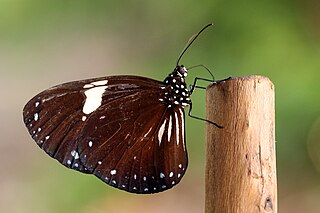Related Research Articles

Athyma selenophora, the staff sergeant, is a species of nymphalid butterfly found in tropical and subtropical Asia.

Euploea radamanthus, the magpie crow, is a butterfly found in India and Southeast Asia that belongs to the danaid group of the brush-footed butterflies family.

Orthomiella pontis, the straightwing blue, is a small butterfly found in India that belongs to the lycaenids or blues family.

Jamides bochus, the dark cerulean, is a small butterfly found in Indomalayan realm that belongs to the lycaenids or blues family. The species was first described by Caspar Stoll in 1782.

Junonia hierta, the yellow pansy, is a species of nymphalid butterfly found in the Palaeotropics. It is usually seen in open scrub and grassland habitats.

Hypolimnas misippus, the Danaid eggfly, mimic, or diadem, is a widespread species of nymphalid butterfly. It is well known for polymorphism and mimicry. Males are blackish with distinctive white spots that are fringed in blue. Females are in multiple forms that include male-like forms while others closely resemble the toxic butterflies Danaus chrysippus and Danaus plexippus. They are found across Africa, Asia, and Australia. In the new world they are found in the West Indies, with strays in Central and North America.

Callenya melaena, the metallic hedge blue, is a small butterfly found in India that belongs to the lycaenids or blues family.
Zacorisca aglaocarpa is a species of moth of the family Tortricidae. It is found on Seram Island in Indonesia and in India.
Zacorisca daphnaea is a species of moth of the family Tortricidae. It is found on New Guinea.
Eunebristis zachroa is a moth in the family Gelechiidae. It was described by Meyrick in 1914. It is found in Guyana.
Onebala iridosoma is a moth in the family Gelechiidae. It was described by Meyrick in 1918. It is found in Australia, where it has been recorded from Queensland.
Charistica ioploca is a moth in the family Gelechiidae. It was described by Meyrick in 1922. It is found in Brazil (Amazonas).
Charistica sandaracota is a moth in the family Gelechiidae. It was described by Meyrick in 1914. It is found in Guyana.
Compsolechia amaurota is a moth of the family Gelechiidae. It was described by Meyrick in 1914. It is found in Guyana.
Thiotricha pancratiastis is a moth of the family Gelechiidae. It was described by Meyrick in 1921. It is found in India (Assam) and Japan.
Antaeotricha caenochytis is a moth of the family Depressariidae. It is found in Guyana and Brazil.
Antaeotricha thapsinopa is a moth of the family Depressariidae. It is found in French Guiana.
Iulactis insignis is a moth in the family Xyloryctidae. It was described by Meyrick in 1904. It is found in Australia, where it has been recorded from New South Wales and Queensland.
Idiocrates balanitis is a moth in the family Depressariidae, and the only species in the genus Idiocrates. It was described by Meyrick in 1909 and is found in Bolivia.
Antaeotricha malachita is a moth in the family Depressariidae. It was described by Edward Meyrick in 1915. It is found in Guyana and Brazil.
References
| This article on a moth of the family Xyloryctidae is a stub. You can help Wikipedia by expanding it. |